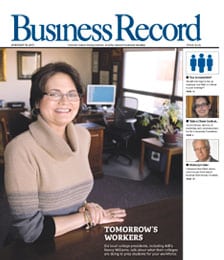JNJ no mere Band-Aid for portfolio

Dear Mr. Berko:
In early 1992, I inherited 200 shares of Johnson & Johnson at a basis of $96 a share, or almost $20,000. Today, I have 800 shares worth about $42,000, and this stock makes up almost 40 percent of my stock holdings.
My other five investments are in mutual funds with Vanguard and Janus, and they have not done very well the past few years. The reason I mention this is that my brother-in-law just became licensed and has gone to work with an agency selling insurance and mutual funds. He says I have too much of my money in Johnson & Johnson stock and I think he may be right.
I have $107,000 invested in stocks and mutual funds. My brother-in-law wants me to sell 600 shares of Johnson & Johnson for about $31,500 and put the proceeds in a variable annuity with ManuLife that has attractive investment guarantees.
I would like your opinion on this approach. We won’t have to touch this money for a long time, if ever. P.D., Durham, N.C.
Dear P.D.:
Doing business with family members, especially lending money, often turns nasty. But your brother-in-law may be right. Your 800 shares of Johnson & Johnson (JNJ-$56) represent 39 percent of your portfolio, and that is potentially dangerous to your good wealth should the shares collapse.
However, telling you to sell JNJ is practically un-American, sort of like desecrating the flag or refusing to stand when they sing “The Star-Spangled Banner” at a baseball game.
JNJ might be one of the best diversified players in the health-care sector. Its $37 billion in 2002 revenues derives from three business segments:
Consumer products accounts for 21 percent of revenues and 13 percent of net profits. So if you use Tylenol, Simply Stuffy, Johnson’s Baby Shampoo, Safety Swabs, Carefree Pantiliners, Stayfree Pads, Neutrogena skin-care products or Band-Aid products, then you’re a Johnson & Johnson devotee.
Pharmaceuticals account for 45 percent of sales and 65 percent of profits. If your physician has prescribed Duragesic, Nizoral, Risperdal, Remicade, Retavase, Modicon, Ortho-Novum, Doxil, Eprex or Procrit, you are a JNJ customer.
Medical devices and diagnostics include wound closure products, surgical accessories, orthopedic products, stents, angioplasty catheters, joint replacements, laboratory research, etc.
Since you inherited this stock in 1992, this supercalifragilistic company has nearly tripled its revenues from $12.6 billion to $36.3 billion last year. Net income increased from $1.5 billion in 1992 to $6.8 billion last year, dividends have grown almost fourfold to 82 cents, net profit margins increased 50 percent, book value and cash flow grew more than fourfold and common stock represents an extremely healthy 91 percent of capital.
JNJ has an excellent research and development department and a superb drug pipeline. Management continues to introduce new products and the company’s nonpareil marketing department steps to the plate and ramps up revenues each year.
The company’s financial strength is superior in almost every way to its sector and so are its profitability ratios. Earnings for this year are expected to improve by 18 percent over 2002, and Value Line’s Nancy Chow thinks they could reach $3.70 per share by 2007-08.
But every once in a while, you have to prune your garden to help the flowers grow. I think JNJ’s torrid growth may begin to slow and that its formidable pharmaceutical division is going run into stiff competition. I’d follow your brother-in-law’s advice, but sell just 400 shares not 600.
I’m very comfortable putting those proceeds, after taxes, into a variable annuity, even if the salesman is your brother-in-law. There are a few variable annuities I would recommend, but ManuLife’s variable (ManuLife is a good life insurance company) couldn’t light my fire with a blowtorch.
I have sent you literature on Equitable, which I think is cool beans. They have desirable policy riders (cost a smidgen more) that are written to provide you with comfortable guarantees. I really like the annual 6 percent living benefit. In my opinion, this variable annuity is a shrewd and sweet investment that could make your financial future a lot more predictable by eliminating substantial risks.
Please address your financial questions to Malcolm Berko, P.O. Box 1416, Boca Raton, Fla. 33429 or e-mail him at malber@adelphia.net.







